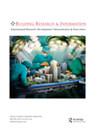Understanding the influencing factors of heritage building maintenance management: findings from developed and developing regions
IF 3.7
3区 工程技术
Q1 CONSTRUCTION & BUILDING TECHNOLOGY
引用次数: 5
Abstract
ABSTRACT Heritage buildings (HBs) have been identified as iconic buildings vital to sustainable development. Unlike modern buildings that can be maintained without conserving cultural significance, HBs are typically symbols of cultural identity that necessitate specific maintenance management. While effective HB maintenance is critical, research on the influencing factors (IFs) of HB maintenance management (HBMM) is limited. This study investigated IFs in developed and developing regions, namely Hong Kong (HK) and Nigeria, to fill this research gap. First, a systematic literature review was conducted, which resulted in the identification of 17 IFs. Then, a questionnaire survey was conducted to solicit maintenance practitioners’ opinions on the effects of the IFs on HBMM. The Mann–Whitney U test was used to identify commonalities and disparities among 154 valid survey responses. The findings reveal that while the respondents agreed on some IFs’ importance, including international statutory protection guiding HB use, they held divergent opinions about other IFs, which include cultural/religious attachment to HBs. This study revealed the distinctiveness between HK and Nigeria regarding the factors influencing HBMM and provided insights for future researchers to further explore the understudied areas of HBMM. The study’s recommended measures can also help to improve and inform HBMM policy-making.了解遗产建筑维护管理的影响因素:发达和发展中地区的研究结果
摘要遗产建筑已被认定为对可持续发展至关重要的标志性建筑。与可以在不保留文化意义的情况下进行维护的现代建筑不同,HBs通常是文化身份的象征,需要具体的维护管理。虽然有效的HB维护至关重要,但对HB维护管理影响因素的研究却很有限。本研究调查了香港和尼日利亚等发达和发展中地区的国际单项体育联合会,以填补这一研究空白。首先,进行了系统的文献综述,确定了17个国际单项体育联合会。然后,进行了一项问卷调查,征求维修从业者对IFs对HBMM影响的意见。Mann-Whitney U检验用于确定154份有效调查回复的共性和差异。调查结果显示,尽管受访者同意一些国际单项体育联合会的重要性,包括指导乙肝使用的国际法定保护,但他们对其他国际单项体育联持不同意见,包括对乙肝的文化/宗教依恋。这项研究揭示了香港和尼日利亚在影响HBMM的因素方面的差异,并为未来的研究人员进一步探索HBMM研究不足的领域提供了见解。该研究建议的措施也有助于改善HBMM的决策并为其提供信息。
本文章由计算机程序翻译,如有差异,请以英文原文为准。
求助全文
约1分钟内获得全文
求助全文
来源期刊

Building Research and Information
工程技术-结构与建筑技术
CiteScore
8.60
自引率
7.70%
发文量
43
审稿时长
>12 weeks
期刊介绍:
BUILDING RESEARCH & INFORMATION (BRI) is a leading international refereed journal focussed on buildings and their supporting systems. Unique to BRI is a focus on a holistic, transdisciplinary approach to buildings and the complexity of issues involving the built environment with other systems over the course of their life: planning, briefing, design, construction, occupation and use, property exchange and evaluation, maintenance, alteration and end of life. Published articles provide conceptual and evidence-based approaches which reflect the complexity and linkages between cultural, environmental, economic, social, organisational, quality of life, health, well-being, design and engineering of the built environment.
 求助内容:
求助内容: 应助结果提醒方式:
应助结果提醒方式:


